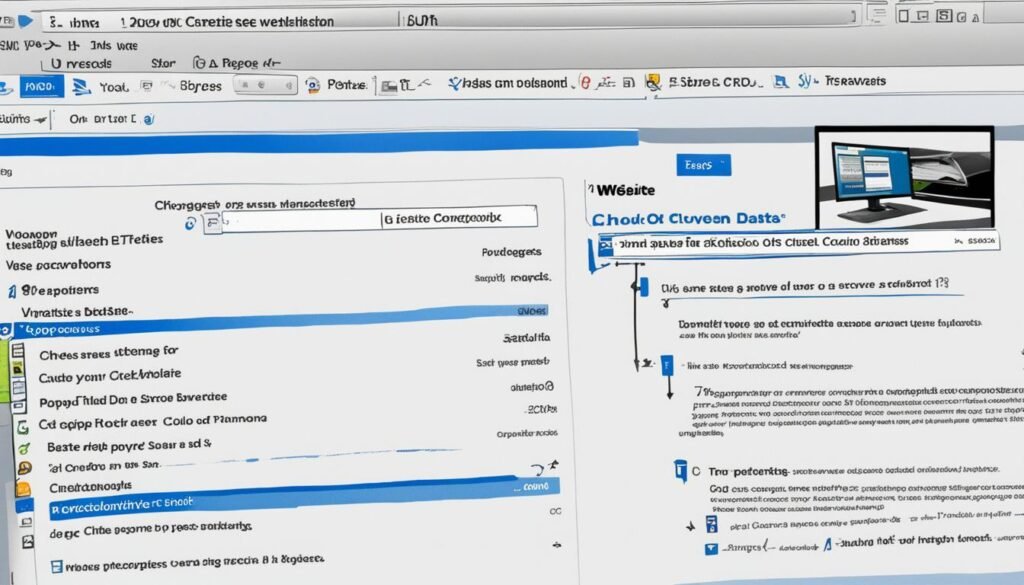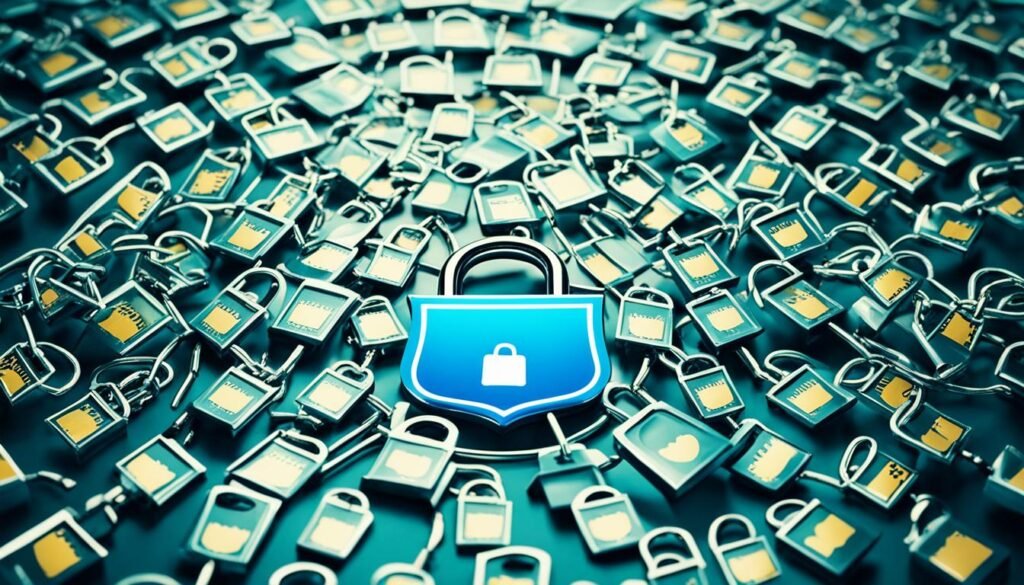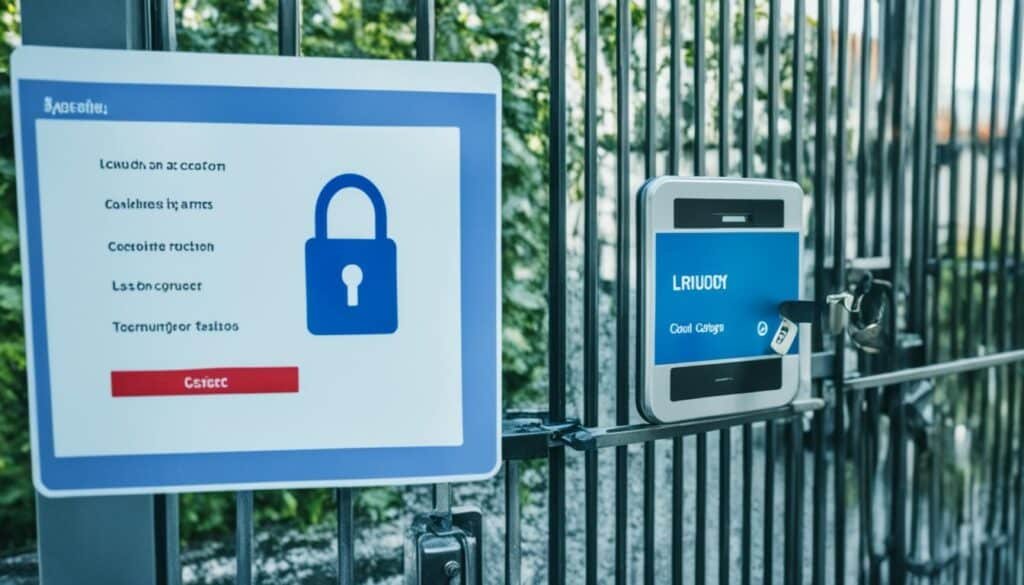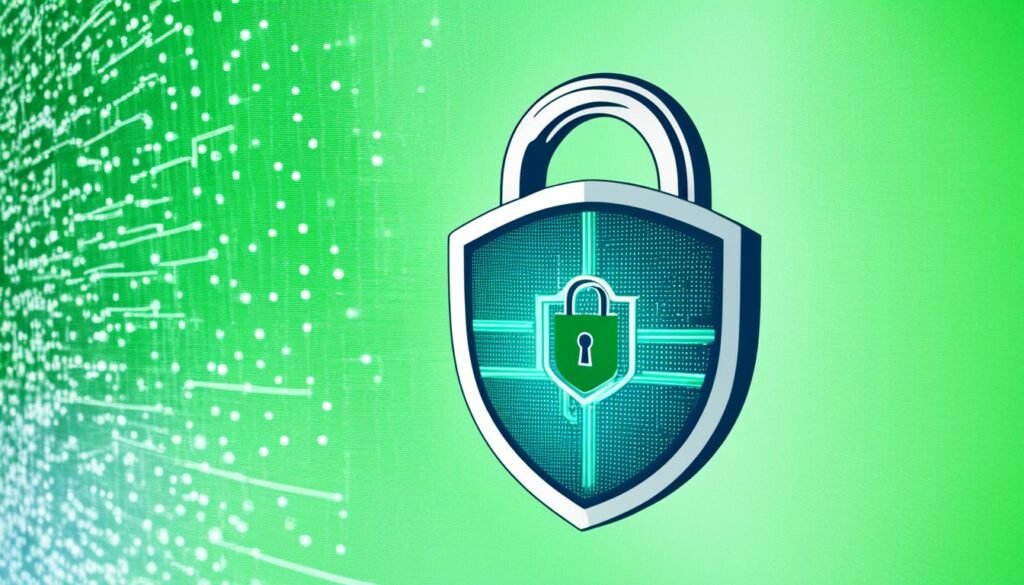Ensuring the security of your blog is essential to safeguard your hard work and protect against cyber threats. Implementing security measures can prevent hacking, data breaches, and other malicious activities. By following these easy steps, you can protect your blog and maintain its integrity.
Key Takeaways: Cyber Threats
- Implementing security measures is crucial for protecting your blog against cyber threats.
- Regularly back up your website to prevent data loss in the event of a hack.
- Choose a reliable web host that prioritizes blog security.
- Install a security plugin to enhance the protection of your blog.
- Secure your login page to prevent brute force attacks.
Importance of Blog Security
As a blogger, you pour your heart and soul into creating valuable content and engaging with your audience. However, in the vast digital landscape, cyber threats lurk around every corner, ready to disrupt your hard work. That’s why ensuring the security of your blog is of utmost importance.
Protecting your blog from cyber threats such as bots, hackers, and technology failures is crucial for the safety and longevity of your website. By prioritizing blog security, you not only safeguard your content and income but also create a robust platform for efficient blogging.
Why is Blog Security Important?
“Blog security is like a fortress that shields your website from the relentless attacks of cybercriminals. It not only secures your content and data but also instills confidence in your audience, knowing that their information is safe.”
Here are some key reasons why blog security should be a top priority:
- Protection against cyber threats: From malicious bots attempting to exploit vulnerabilities to hackers targeting sensitive information, blog security measures act as a strong defense against various cyber threats.
- Safeguarding your content: Your blog is a treasure trove of valuable content that represents your hard work and expertise. Implementing security measures ensures the integrity and availability of your content, preventing unauthorized access and data breaches.
- Preserving your income: Many bloggers generate income through their websites, whether through ad revenue, sponsored content, or e-commerce. A secure blog helps maintain uninterrupted revenue streams by protecting financial transactions and preventing fraudulent activities.
- Enhancing user trust: Building trust with your audience is essential. A secure blog signals to your visitors that you value their privacy and take their online safety seriously, fostering a sense of confidence and loyalty.
With the importance of blog security established, let’s explore practical steps to protect your valuable online presence.
| Benefits | Actions |
|---|---|
| Protection against cyber threats | Implement security measures, such as firewalls and intrusion detection systems. |
| Safeguarding your content | Regularly back up your blog’s data and content. |
| Preserving your income | Secure online transactions with encryption technologies and reliable payment gateways. |
| Enhancing user trust | Display security seals or badges on your blog to reassure visitors. |
Back Up Your Website Regularly

One of the most important steps you can take to protect your blog from hacking and prevent data loss is to regularly back up your website. By creating backups, you ensure that you always have a copy of your blog’s content and data that you can revert to in case of any issues or security breaches. Backing up your website is like having an insurance policy for your blog, providing you with peace of mind and a safety net in case of emergencies.
It is highly recommended to have daily backups of your blog’s content and database. This way, you can minimize any potential data loss and quickly restore your blog to its previous state if needed. Many hosting services provide automatic daily backups as part of their package, so be sure to take advantage of this feature if it is available. In addition, you may also consider using third-party backup solutions that offer more control and flexibility over your backups.
It is essential to keep in mind that backups are not only useful in the event of hacking or cyber attacks but also when making significant updates or changes to your blog. Before making any major updates, such as installing new themes or plugins, or modifying your blog’s settings, it is wise to run an on-demand backup to preserve your blog’s current state. This way, if anything goes wrong during the update process, you can easily revert to the backup and avoid any potential issues, saving you time and effort.
The Importance of Offsite Backups
While having backups is crucial, it is equally important to store your backups in a secure location separate from your live website. This is known as offsite backups. Offsite backups ensure that even in the event of catastrophic incidents, such as server failures or natural disasters, your backups remain safe and accessible.
“Regularly backing up your website is like having an insurance policy for your blog, providing you with peace of mind and a safety net in case of emergencies.”
There are several options for offsite backups. Some hosting providers offer remote backup storage as part of their services or as an add-on feature. Alternatively, you can use cloud storage services like Dropbox, Google Drive, or Amazon S3 to securely store your backups. Whichever method you choose, make sure you have a reliable backup strategy in place to protect your valuable blog content and data.
Taking Action Today
Don’t wait until it’s too late. Take the necessary steps to back up your website regularly and protect against hacking and data loss. Remember, prevention is always better than cure, and having regular backups ensures that you can quickly restore your blog and get back to sharing your valuable content with your audience.
Choose a Reliable Web Host

Selecting a trustworthy web host is crucial for maintaining blog security and protecting against potential threats. When choosing a web host, it is important to prioritize security and select a provider that has robust hosting security measures in place.
Shared servers can pose risks if other websites on the server have lax security protocols. Therefore, it is recommended to choose a web host that prioritizes security and implements strong measures to safeguard your blog.
Here are some essential factors to consider when choosing a reliable web host:
- Security Measures: Ensure that your web host takes blog security seriously and has comprehensive security measures in place. Look for features like firewall protection, intrusion detection systems, and malware scanning.
- SSL Certificates: Check if your web host offers free SSL certificates. An SSL certificate provides encryption and enhances the security of data transmitted between your blog and visitors.
- Backups: Determine if your web host provides regular backups of your blog. Regular backups can help minimize the impact of security incidents and restore your blog to a previous secure state.
- Support: Consider the level of technical support provided by the web host. In case of security issues or concerns, it is important to have access to responsive support that can assist you promptly.
By selecting a reliable web host that prioritizes security, you can ensure that your blog is protected from potential threats and provide a safe browsing experience for your visitors.
Install a Security Plugin

Enhancing the security of your blog is crucial in safeguarding your website and protecting it against hackers and malicious activities. One effective measure you can take is to install a reliable security plugin. These plugins offer comprehensive features designed to fortify your blog’s defense against potential threats. With a wide variety of security plugins available, you can choose one that suits your specific needs and preferences.
One highly recommended security plugin is All In One WP Security & Firewall. This plugin provides robust protection for your website and is relatively simple to set up. By configuring the plugin settings and utilizing its features, you can significantly enhance the security of your blog and ensure its continuous operation without the risk of unauthorized access or data breaches.
Here are some key benefits of installing a security plugin:
- Website Protection: A security plugin acts as a reliable shield, protecting your blog from potential cyber threats and unauthorized access attempts.
- Hacker Deterrent: Many security plugins include features like firewall protection, IP blocking, and login security measures that discourage hackers from targeting your website.
- Malware Detection: Security plugins often include scanning functionalities that can identify and notify you of any malware or suspicious activities on your blog.
- Vulnerability Assessment: These plugins can perform regular scans to identify any vulnerabilities in your blog’s code or configurations, allowing you to address them promptly.
- Security Audit: Some security plugins offer audit features that provide insights into your blog’s security performance, enabling you to make better-informed decisions for ongoing protection.
By installing a security plugin, you can proactively protect your blog, its content, and the sensitive information of your visitors. The enhanced security measures not only provide peace of mind but also contribute to the overall professionalism and credibility of your online presence.
“Installing a security plugin is like hiring a reliable guard to protect your blog from potential threats. It acts as a proactive defense mechanism, ensuring that your website remains secure and your valuable content is preserved.”
| Top Security Plugins | Key Features |
|---|---|
| WordFence | – Firewall Protection – Malware Scanning – Login Security |
| Sucuri | – Web Application Firewall – Malware Detection – Security Alerts |
| Security Ninja | – Vulnerability Scanning – Security Tweaks – Database Backup |
| All In One WP Security & Firewall | – User Account Security – Brute Force Attack Prevention – File System Security |
Secure Your Login Page

Protecting your login page is crucial to prevent brute force attacks. Brute force attacks occur when hackers attempt to gain unauthorized access to your website by systematically guessing usernames and passwords.
To enhance your login page security:
- Change the default login URL: By changing the default login URL provided by WordPress to a custom URL, you can add an extra layer of protection. Utilize a security plugin like WPS Hide Login to easily modify the login URL.
- Limit login attempts: Implement a limit on the number of login attempts a person can make. This prevents hackers from repeatedly trying different username and password combinations. Consider using a plugin like Limit Login Attempts Reloaded to set a specific threshold.
- Use strong usernames and passwords: Avoid using default usernames like “admin” and create strong, unique usernames and passwords instead. Use a combination of uppercase and lowercase letters, numbers, and special characters to enhance security.
By following these measures, you can significantly reduce the risk of unauthorized access to your blog through brute force attacks.
Remember, maintaining a secure login page is just one aspect of overall blog security. Be sure to implement a comprehensive security strategy to protect your blog from various cyber threats.
| Benefits of Secure Login Page | Actions |
|---|---|
| Preventing unauthorized access | Change the default login URL Limit login attempts Use strong usernames and passwords |
| Protecting user data | Implement two-factor authentication Encrypt login credentials |
| Reducing the risk of brute force attacks | Implement login rate limiting Use CAPTCHA verification |
Control Access to Your Blog

When it comes to protecting your blog, controlling access is key. Safeguarding your login credentials and limiting access to your admin account is essential for maintaining the security of your blog. By being cautious about who you share your login details with, you can significantly reduce the risk of unauthorized access and potential security breaches.
If you need to provide access to others, it’s best to create separate user accounts with limited access instead of sharing your admin login. This way, you can grant specific permissions to individuals without compromising the overall security of your blog.
WordPress, the popular content management system, offers convenient user roles that you can assign to different accounts. These roles, such as author or contributor, allow individuals to manage their own content while ensuring limited access to sensitive areas of your blog. By utilizing these user roles, you can maintain better control over your blog’s security.
Remember, it’s always better to err on the side of caution when it comes to sharing login credentials. Only provide access to those who genuinely require it and ensure they understand the importance of maintaining good security practices. Taking these measures will help protect your blog from unauthorized access and potential vulnerabilities.
Benefits of Controlling Access:
- Minimizes the risk of unauthorized access and security breaches
- Allows you to grant specific permissions to individuals without compromising overall security
- Maintains control over sensitive areas of your blog
- Promotes better security practices among users
Keep Software Updated

Regularly updating your software is crucial for optimizing the security of your blog. By keeping your server’s operating system, content management system (CMS), plugins, and themes up to date, you can ensure that your blog is protected against potential security vulnerabilities.
Software updates often include important security patches that address known vulnerabilities and strengthen the overall security of your blog. Failing to install these updates promptly can leave your blog exposed to potential threats and cyberattacks.
To prioritize software updates, consider implementing the following best practices:
Create a Schedule for Updates
Establish a regular schedule for checking and installing software updates. This could be weekly, bi-weekly, or monthly, depending on the frequency of updates released by your CMS, plugins, and themes. By sticking to a schedule, you can ensure that you don’t miss any critical security patches or bug fixes.
Enable Automatic Updates
Whenever possible, enable automatic updates for your CMS, plugins, and themes. This feature ensures that your software is always up to date without requiring manual intervention. However, it is still essential to periodically check your blog to confirm that automatic updates are functioning correctly and that there are no issues.
Backup Your Blog Before Updating
Before installing any software updates, it is recommended to backup your blog. This precautionary measure allows you to restore your blog to a previous working state in case any issues arise during the update process. It is advisable to have both an offsite backup and an on-site backup for added security.
Stay Informed About Updates
Stay informed about software updates by subscribing to newsletters, following relevant blogs and forums, and joining online communities of bloggers. These sources often provide timely information about new releases, security patches, and best practices for updating your blog’s software.
Keeping your software updated is a fundamental aspect of blog security. By implementing a proactive approach to software updates, you can ensure that your blog remains protected against potential security threats and exploits.
Implement SSL and HTTPS

Securing the transmission of data and protecting sensitive information on your blog is of utmost importance. By implementing an SSL certificate and enabling HTTPS, you can ensure the encryption of communication between your server and users, safeguarding against eavesdropping and tampering attempts.
Many web hosts offer free SSL certificates, making it affordable and accessible for bloggers to enhance their website’s security. Enabling HTTPS is typically a straightforward process, and it involves configuring your blog to work exclusively on this secure protocol.
By leveraging an SSL certificate and HTTPS, you can provide a secure browsing experience for your visitors and instill confidence in their interactions with your blog.
To implement SSL and HTTPS on your blog:
- Obtain an SSL certificate from your web host or a trusted certificate authority.
- Configure your server to install the SSL certificate and enable HTTPS.
- Update your WordPress settings to work exclusively on HTTPS.
Once these steps are complete, your blog will benefit from secure data transmission, protecting both you and your visitors from potential security threats.
Benefits of SSL and HTTPS:
Implementing SSL and HTTPS on your blog offers numerous advantages, including:
- Data Protection: Encryption of sensitive information, such as login credentials, personal data, and payment details, prevents unauthorized access.
- Improved SEO: Search engines prioritize secure websites and may boost your blog’s rankings in search results.
- Enhanced Trust: By displaying the padlock symbol and “Secure” label in web browsers, visitors perceive your blog as trustworthy and reliable.
- Compliance: Some regulations and standards, such as the GDPR, require websites to implement SSL and protect user data.
Ensure you prioritize the implementation of SSL and HTTPS on your blog to establish a secure digital environment for your visitors and protect the integrity of your website.
| SSL Certificate | Website Encryption | Secure Data Transmission |
|---|---|---|
| Protects sensitive information | Encrypts communication between server and users | Prevents eavesdropping and tampering |
| Obtained from trusted sources | Ensures data remains private and secure | Elevates user trust and confidence |
| Improves SEO ranking | Complies with regulations and standards | Establishes a safe browsing experience |
Monitor and Scan Your Blog
Regularly scanning your blog for vulnerabilities and monitoring its security is crucial for identifying potential threats. By proactively detecting and addressing security risks, you can protect your blog from cyber attacks and ensure its continued operation.
Utilize Automated Vulnerability Scanning Tools
One effective way to scan your blog for vulnerabilities is to utilize automated vulnerability scanning tools. These tools can check for known security issues and help you identify potential weaknesses in your blog’s security infrastructure. Consider using popular vulnerability scanning tools like Acunetix, Nessus, or OpenVAS to run automated scans and receive detailed reports on any vulnerabilities detected.
Periodic Penetration Testing
In addition to automated vulnerability scans, consider conducting periodic penetration testing on your blog. Penetration testing involves simulating real-world attacks to identify security vulnerabilities in your blog’s infrastructure. Engaging professional security experts to conduct these tests can help you gain valuable insights into your blog’s security posture and address any weaknesses before they are exploited by malicious actors.
Implement Malware Scanning
Malware can pose a significant threat to your blog’s security and the integrity of your website. Implementing malware scanning tools can help detect and remove any malicious software that may have infected your blog. Consider using reputable security plugins like Sucuri or Wordfence which offer comprehensive malware scanning and removal features.
Web Application Firewall (WAF)
Another effective security measure is to implement a web application firewall (WAF) on your blog. A WAF acts as a protective layer between your website and potential threats, filtering out malicious traffic and preventing unauthorized access attempts. Consider using popular WAF solutions such as ModSecurity or Incapsula to enhance the security of your blog.
Regular monitoring and scanning of your blog, along with the implementation of automated vulnerability scanning tools, periodic penetration testing, malware scanning, and a web application firewall, are crucial steps in ensuring the security and integrity of your blog. Taking these proactive measures can help you detect and mitigate potential threats, protecting your blog and giving you peace of mind.
In the realm of cybersecurity, understanding the common types of cyber threats is crucial for organizations to protect against cyber dangers posed by cyber criminals and threat actors. These threats can manifest in various forms, including malicious cyber attacks targeting key infrastructure and exploiting security vulnerabilities in supply chains.
Cyber threat intelligence provides insight into the evolving cyber threat landscape, enabling security teams to implement advanced security measures and protocols to defend against sophisticated cyber threats. From advanced persistent threats to formless cyber dangers, security solutions and best practices are essential to prevent and mitigate the impact of cyber attacks. By staying informed about multiple types of cybersecurity threats and honing cyber skills, organizations can effectively safeguard against malicious cyber threats and ensure the security of their digital assets in the face of evolving cyber threats.
Also Read : Get Help Fast From Google Ads Customer Service
Conclusion
Protecting your blog from cyber threats is crucial to maintaining its integrity and ensuring the safety of your content and income. By implementing a few best practices, you can significantly enhance the security of your blog and mitigate the risks posed by cyber threats.
First and foremost, regularly backing up your website is essential. By having recent backups readily available, you can quickly restore your blog in the event of a hacking or data breach. Consider utilizing a reliable web host that prioritizes security measures and offers strong hosting security features.
Installing a security plugin, such as WordFence or All In One WP Security & Firewall, is another effective way to protect your blog. These plugins provide comprehensive security features and help detect and block potential threats. Secure your login page by using a custom URL, limiting login attempts, and using strong usernames and passwords.
Furthermore, keeping your software up to date is crucial, as software updates often include security patches that address vulnerabilities. Enable SSL and HTTPS on your blog to encrypt data transmission and ensure secure communication between your server and users. Finally, regularly monitor and scan your blog for vulnerabilities and consider employing a web application firewall to filter out malicious traffic.
By following these blog security best practices, you can significantly reduce the risk of cyber threats and focus on creating valuable content and engaging with your audience without the constant worry of potential security breaches.
FAQs
Q: What are the common types of cyber threats?
A: Common cyber threats include phishing, ransomware, denial of service (DDoS) attacks, insider threats, malware attacks, and supply chain vulnerabilities.
Q: How can I protect my blog from cyber threats?
A: To protect your blog from cyber threats, you can implement cybersecurity best practices, use security tools, secure your system or network, regularly update your software, educate yourself and your team on phishing attacks and social engineering tactics, and have incident response plans in place.
Q: What are the different types of cyber attacks that can target my blog?
A: Cyber attacks that can target your blog include ransomware attacks, phishing attacks, DDoS attacks, supply chain attacks, malware infections, and insider threats aiming to steal sensitive data or intellectual property.
Q: How do cyber threat actors gain access to information security in a blog?
A: Cyber threat actors can gain access to information security in a blog through various attack vectors such as exploiting vulnerabilities, using social engineering tactics, deploying malicious code, infecting systems with malware, and launching DDoS attacks to disrupt services.
Q: What is the importance of cybersecurity threat intelligence in protecting a blog?
A: Cybersecurity threat intelligence plays a crucial role in protecting a blog as it provides insights into the latest threats, attack trends, and tactics used by cyber threat actors. It helps in proactively identifying and mitigating potential risks to prevent cyber attacks.
Q: How can I defend against distributed denial of service (DDoS) attacks on my blog?
A: To defend against DDoS attacks, you can implement DDoS protection services, use web application firewalls, monitor network traffic for anomalies, distribute servers across multiple locations, and have a response plan in place to mitigate the impact of DDoS attacks.
Q: What are some best practices to prevent supply chain vulnerabilities in a blog?
A: To prevent supply chain vulnerabilities in a blog, you can establish strong security controls, vet third-party vendors, monitor supply chain activities, secure access to critical infrastructure, conduct regular security assessments, and have protocols in place to respond to incidents involving the supply chain.
Source Links
- https://www.productiveblogging.com/protect-your-blog/
- https://webheadtech.com/blog/protect-your-website/
- https://www.indusface.com/blog/effective-ways-for-website-protection/





